The Daily Reid: Blessed are the peacemakers...
Pope Francis dies on Easter Monday, not long after meeting with the nominal number two man in the viciously anti-immigrant U.S regime
I haven’t been Catholic since I was maybe six years old. My mom, Philomena Carryl Lomena (and yes, I know it’s weird that a woman named Philomena managed to find a husband whose surname was Lomena) was an Anglican when she came to the U.S. And my father, Sebastien Ibeke Lomena, her Congolese boo thang, was Catholic. He won the day, for a while, when she had both my older sister June and me baptized Catholic. It was all well and good until she had to deal with us at church, once we were old enough to understand the concept of “vaulted ceilings.”
The way Philomena told the story to me decades ago when I was in high school, and wanted to know why we were Methodists and not Baptists like the fun church that rented out the United Church of Montbello after our services, our conversion to “quiet church” went as follows. We were inside a beautiful Catholic cathedral one Sunday in Denver, where we moved after my parents broke up the first time when I was two (only to get back together and produce my younger brother, who may or may not have been in my mother’s lap at the time.) My sister and I were marveling at the high, vaulted ceilings. What I personally remember was looking way up into the vaults and marveling at the intricate carvings and at the stained glass windows on all sides of the edifice. And I remember having this little blue purse that was a kind of thick plastic material at the bottom with a white macrame top that closed with a drawstring. I had the blue one, and June had the red one. It’s one of my strongest memories of being a little kid. If I close my eyes, I can still see that little purse.
At some point, either June or I hopped off the pew and ducked underneath it. I don’t know which of us was the troublemaker but we were a dynamic duo so if one Lomena girl did it, as Philomena would say, the other would be their lawyer. And while we were generally well behaved kids, this time, we decided to test those vaulted ceilings, and Philomena’s patience. One of us let out an “ahh!” which echoed into the rooftops. The other followed, and we kept doing it despite my distinctly feeling my mother’s fingers pinching my arm, trying to get us to stop. The next church I remember attending was a humdrum, low ceilinged Methodist church with no vaulted ceilings and no gorgeous stained glass windows. Philomena wasn’t about to let vaulted ceilings and annoying daughters get in the way of her worship of the Lord.
A pope for the immigrant and the victims of war
While no longer a Catholic, I have remained fascinated by the Vatican — its mysteriousness and ornateness. Not just the physical building but also the politics within it. In high school, it was John Paul II whose exploits I followed on TV news. Throughout the 1980s he symbolically battled the Soviet Union through his embrace of Lech Walesa, the leader of Poland’s banned Solidarity trade union, while Poland was buckling under 5 and a half years of Communist martial law. The good Polish pontiff was brave and forthright in a way that made you revere the moral grandeur of the Catholic State. But he remained a distant, historical figure, at least to this former Catholic. And Reagan seemed to like him, which made me give him a bit of the side eye. In fact, in 1982, when I was in junior high, Reagan became the first U.S. president to meet with a pope alone. As author Steve Berry recounts:
For 50 minutes Ronald Reagan and John Paul II spoke in private. To this day no one knows about what. No agenda existed, no recording was made, no notes taken. And what a pair they made. One man the leader of the free world, commanding the most powerful military and shepherding the most vibrant economy on the planet. The other the spiritual beacon of a billion-plus Catholics, millions of whom had lived for decades in eastern Europe under the harsh yoke of communism. Many books have been written about both men, that fateful meeting nearly always included. Some historians are convinced that a deal was made, an tacit agreement of cooperation, both men having survived an assassin’s bullet, both men sharing a common goal: the end of communism. It’s hard to conclude anything for certain. What we do know is that over the next 6 years Ronald Reagan and John Paul II brought the Soviet Union to its knees.
The U.S. has had a fraught history with the Catholic faith. Catholics were long held in suspicion by Make America Great Again WASPs, including the white “Christians” of the Ku Klux Klan. In 1928, Herbert Hoover rode anti-Catholic bigotry to defeat Irish Catholic New York governor Al Smith, who wanted to roll back prohibition.
On his way to becoming our first Catholic president, JFK had to contend with accusations that he would be a puppet of the red clothed shoe papists. Indeed, only two Catholics have ever been elected president of the United States: JFK and Joe Biden, though the Supreme Court has come to be dominated by a 6-3 Catholic majority, including the vicious one-two-punch of Clarence Thomas and Samuel Alito. My guess is Leonard Leo picked the five conservative Catholics on the high court because he knew they would be reliably anti-abortion.
But I digress…
If John Paul II was a pope for the anti-Communist, anti-authoritarian resistance, Cardinal Ratzinger, who became Pope Benedict XVI when he succeeded Pope John Paul II in 2005, was a pope for the right wing moral scolds. He brought back not just the pricey ruby silk slippers to the papacy, but also the doctrinaire hard line against gays, during the Bush era in the U.S., when the American right — particularly the neocon war hawks, and right wing religious zealots, seemed to be at their zenith. (Who knew how much worse they would get!) It was the now-familiar marriage of militarism, religious fundamentalism, and the right wing drive toward a “unitary executive” monarchy. Pope Ratzinger fit right in. He also fit into the notion of male impunity, given how strictly he seemed to ignore the child sexual abuse scandals rippling across the global church.
And while it’s not really true that popes tend to vibe with the U.S. presidents who come to power when they do, the shift from Ratzinger to an Argentinian former Jesuit priest, Jorge Mario Bergogli in 2013 had some serious Barack Obama era vibes. This was the official biography of the man who would deemed Pope Francis, better known by his Twitter handle @pontifex :
The first Pope of the Americas Jorge Mario Bergoglio hails from Argentina. The 76-year-old Jesuit Archbishop of Buenos Aires is a prominent figure throughout the continent, yet remains a simple pastor who is deeply loved by his diocese, throughout which he has travelled extensively on the underground and by bus during the 15 years of his episcopal ministry.
“My people are poor and I am one of them”, he has said more than once, explaining his decision to live in an apartment and cook his own supper. He has always advised his priests to show mercy and apostolic courage and to keep their doors open to everyone. The worst thing that could happen to the Church, he has said on various occasions, “is what de Lubac called spiritual worldliness”, which means, “being self-centred”. And when he speaks of social justice, he calls people first of all to pick up the Catechism, to rediscover the Ten Commandments and the Beatitudes. His project is simple: if you follow Christ, you understand that “trampling upon a person’s dignity is a serious sin”.
Despite his reserved character — his official biography consists of only a few lines, at least until his appointment as Archbishop of Buenos Aires — he became a reference point because of the strong stances he took during the dramatic financial crisis that overwhelmed the country in 2001.
He was born in Buenos Aires on 17 December 1936, the son of Italian immigrants. His father Mario was an accountant employed by the railways and his mother Regina Sivori was a committed wife dedicated to raising their five children. He graduated as a chemical technician and then chose the path of the priesthood, entering the Diocesan Seminary of Villa Devoto. On 11 March 1958 he entered the novitiate of the Society of Jesus. He completed his studies of the humanities in Chile and returned to Argentina in 1963 to graduate with a degree in philosophy from the Colegio de San José in San Miguel. From 1964 to 1965 he taught literature and psychology at Immaculate Conception College in Santa Fé and in 1966 he taught the same subject at the Colegio del Salvatore in Buenos Aires. From 1967-70 he studied theology and obtained a degree from the Colegio of San José.
On 13 December 1969 he was ordained a priest by Archbishop Ramón José Castellano. He continued his training between 1970 and 1971 at the University of Alcalá de Henares, Spain, and on 22 April 1973 made his final profession with the Jesuits. Back in Argentina, he was novice master at Villa Barilari, San Miguel; professor at the Faculty of Theology of San Miguel; consultor to the Province of the Society of Jesus and also Rector of the Colegio Máximo of the Faculty of Philosophy and Theology.
On 31 July 1973 he was appointed Provincial of the Jesuits in Argentina, an office he held for six years. He then resumed his work in the university sector and from 1980 to 1986 served once again as Rector of the Colegio de San José, as well as parish priest, again in San Miguel. In March 1986 he went to Germany to finish his doctoral thesis; his superiors then sent him to the Colegio del Salvador in Buenos Aires and next to the Jesuit Church in the city of Córdoba as spiritual director and confessor.
It was Cardinal Antonio Quarracino, Archbishop of Buenos Aires, who wanted him as a close collaborator. So, on 20 May 1992 Pope John Paul II appointed him titular Bishop of Auca and Auxiliary of Buenos Aires. On 27 May he received episcopal ordination from the Cardinal in the cathedral. He chose as his episcopal motto, miserando atque eligendo, and on his coat of arms inserted the ihs, the symbol of the Society of Jesus.
What was wonderful about Pope Francis was his commitment to the red letters of Jesus. He truly brought the poor and the immigrant back to the center of Catholic theology. He rejected right wing bishops who fixated on heaping cruelty on LGBTQ people, and refocused the message of the church on compassion. And he was a stalwart peacemaker, who phoned a Catholic church in Gaza every day since the war on that small strip of earth began after the October 7 attacks by Hamas on southern Israel.
Goin' to lay down my burden, Down by the riverside, Down by the riverside, Down by the riverside; Goin' to lay down my burden, Down by the riverside, to study war no more.
Pope Francis died on the Monday after Easter at age 88, of a brain hemorrage, according to the Holy See. The first line of the AP story on his death says it all:
VATICAN CITY (AP) — Pope Francis, history’s first Latin American pontiff who charmed the world with his humble style and concern for the poor but alienated conservatives with critiques of capitalism and climate change, died Monday. He was 88.
The Vatican said Francis died of a stroke that put him into a coma and led to heart failure.
Bells tolled in Catholic churches from his native Argentina to the Philippines and across Rome as news spread around the world.
“At 7:35 this morning, the Bishop of Rome, Francis, returned to the home of the Father. His entire life was dedicated to the service of the Lord and of his Church,” Cardinal Kevin Farrell said from the chapel of the Domus Santa Marta, where Francis lived.
Francis, who suffered from chronic lung disease and had part of one lung removed as a young man, was admitted to Gemelli hospital on Feb. 14, 2025, for a respiratory crisis that developed into double pneumonia. He spent 38 days there, the longest hospitalization of his 12-year papacy.
Francis did indeed anger conservatives.
Amid international indifference to the slaughter of tens of thousands of men, women and children in Gaza, his final address was a call for peace and a ceasefire to end the war:
Just yesterday, in his Easter Sunday address in Saint Peter’s Square in Vatican City, the leader of the Roman Catholic Church chose to express his “closeness to the sufferings of Christians in Palestine and Israel, and to all the Israeli people and the Palestinian people”.
He went on to state that he was “think[ing] of the people of Gaza, and its Christian community in particular, where the terrible conflict continues to cause death and destruction and to create a dramatic and deplorable humanitarian situation” – a toned-down reference, of course, to Israel’s ongoing genocide in the Gaza Strip, which has officially killed more than 51,200 Palestinians since October 2023.
The people of Gaza, and the suffering Palestinian Christians of Bethlehem and the West Bank, remember him as a “dear friend” and a man of peace. Members of the Israeli right, not so much:
Rafi Schutz, Israel's former ambassador to the Vatican, wrote that he was "the pope who brought the world closer to him and disappointed Israel".
The pope's position on Israel after the start of the war deserved "harsh criticism", Schutz continued, adding that it marked a "significant blow" to Israeli-Vatican relations.
The right-wing newspaper Israel Hayom said the pontiff will be remembered in Israel "mainly for his harsh statements against the war in Gaza".
Similarly, the far-right Channel 14 called him Israel's "harshest critic".
Zvika Klein, the editor-in-chief of the Jerusalem Post, characterised Pope Francis' criticism of Israel and support for Palestinians under its assault as "unconditional support for Hamas".
Cliffs notes: the pope was not a supporter of Hamas, any more than multi-faith Ivy League student protesters are. He was simply a man who wanted Palestinians and Israelis to live in peace. That is why so many Palestinians are heartbroken at his death today.
But I digress again.
Pope Francis was also a passionate believer in the Biblical call to care for the poor, the sick, and the immigrant, as well as to be good stewards of the planet and the environment. Perhaps his Argentinian lineage, which came from his family’s own immigration there, made him especially sensitive. Or maybe it was just … you know … reading the Bible. And since Trump’s return to power, he routinely rebuked the regime for its cruelty toward immigrants, including in his final letter to U.S. Catholic bishops that contained a wave of stinging rebukes:
I am writing today to address a few words to you in these delicate moments that you are living as Pastors of the People of God who walk together in the United States of America.
1. The journey from slavery to freedom that the People of Israel traveled, as narrated in the Book of Exodus, invites us to look at the reality of our time, so clearly marked by the phenomenon of migration, as a decisive moment in history to reaffirm not only our faith in a God who is always close, incarnate, migrant and refugee, but also the infinite and transcendent dignity of every human person.[1]
2. These words with which I begin are not an artificial construct. Even a cursory examination of the Church’s social doctrine emphatically shows that Jesus Christ is the true Emmanuel (cf.Mt1:23); he did not live apart from the difficult experience of being expelled from his own land because of an imminent risk to his life, and from the experience of having to take refuge in a society and a culture foreign to his own. The Son of God, in becoming man, also chose to live the drama of immigration. I like to recall, among other things, the words with which Pope Pius XII began his Apostolic Constitution on the Care of Migrants, which is considered the “Magna Carta” of the Church’s thinking on migration:
“The family of Nazareth in exile, Jesus, Mary and Joseph, emigrants in Egypt and refugees there to escape the wrath of an ungodly king, are the model, the example and the consolation of emigrants and pilgrims of every age and country, of all refugees of every condition who, beset by persecution or necessity, are forced to leave their homeland, beloved family and dear friends for foreign lands.”[2]
3. Likewise, Jesus Christ, loving everyone with a universal love, educates us in the permanent recognition of the dignity of every human being, without exception. In fact, when we speak of “infinite and transcendent dignity,” we wish to emphasize that the most decisive value possessed by the human person surpasses and sustains every other juridical consideration that can be made to regulate life in society. Thus, all the Christian faithful and people of good will are called upon to consider the legitimacy of norms and public policies in the light of the dignity of the person and his or her fundamental rights, not vice versa.
4. I have followed closely the major crisis that is taking place in the United States with the initiation of a program of mass deportations. The rightly formed conscience cannot fail to make a critical judgment and express its disagreement with any measure that tacitly or explicitly identifies the illegal status of some migrants with criminality. At the same time, one must recognize the right of a nation to defend itself and keep communities safe from those who have committed violent or serious crimes while in the country or prior to arrival. That said, the act of deporting people who in many cases have left their own land for reasons of extreme poverty, insecurity, exploitation, persecution or serious deterioration of the environment, damages the dignity of many men and women, and of entire families, and places them in a state of particular vulnerability and defenselessness.
5. This is not a minor issue: an authentic rule of law is verified precisely in the dignified treatment that all people deserve, especially the poorest and most marginalized. The true common good is promoted when society and government, with creativity and strict respect for the rights of all — as I have affirmed on numerous occasions — welcomes, protects, promotes and integrates the most fragile, unprotected and vulnerable. This does not impede the development of a policy that regulates orderly and legal migration. However, this development cannot come about through the privilege of some and the sacrifice of others. What is built on the basis of force, and not on the truth about the equal dignity of every human being, begins badly and will end badly.
That letter was published on February 11th, which weirdly enough would have been my mother’s 96th birthday. I recommend you read it all.
Perhaps JD Vance should have, before he pushed for an Easter Sunday audience with the pope in his waning hours of life, a meeting that the pontiff apparently was not quite keen on, but very graciously went forward with, anyway; even gifting Vance with chocolate eggs for each of “Ushas kids.” The visit apparently lasted 17 minutes from car, to a few minutes of Easter greetings, to a return to the official U.S. government vehicle. Also per the AP, referring to the pope’s February letter:
Vance, who converted to Catholicism in 2019, and the pope have tangled sharply over migration and the Trump administration’s plans to deport migrants en masse. Francis has made caring for migrants a hallmark of his papacy.
Just days before he was hospitalized in February, Francis blasted the deportation plans, warning that they would deprive migrants of their inherent dignity. In a letter to U.S. bishops, Francis also appeared to respond to Vance directly for having claimed that Catholic doctrine justified such policies.
After what would be one of his final meetings with a political leader, Pontifex issued yet another rebuke of the regime and its brother autocracies around the world, with an Easter homily decrying the mistreatment of immigrants and calling once again, for the end to the war on Gaza, and to the conflicts in Europe, Asia and Africa.
"On this day, I would like all of us to hope anew and to revive our trust in others, including those who are different than ourselves, or who come from distant lands, bringing unfamiliar customs, ways of life and ideas! For all of us are children of God!" the message implored, in part.
"There can be no peace without freedom of religion, freedom of thought, freedom of expression and respect for the views of others," the pope's message also declared.
The pope particularly addressed the ongoing conflict in Israel and Gaza: "I express my closeness to the sufferings of Christians in Palestine and Israel, and to all the Israeli people and the Palestinian people. ... I appeal to the warring parties: call a ceasefire, release the hostages and come to the aid of a starving people that aspires to a future of peace!" the message said.
The Easter message also addressed ongoing conflicts in Ukraine and elsewhere, as well as humanitarian crises around the world.
"I appeal to all those in positions of political responsibility in our world not to yield to the logic of fear which only leads to isolation from others, but rather to use the resources available to help the needy, to fight hunger and to encourage initiatives that promote development," the message said. "These are the 'weapons' of peace: weapons that build the future, instead of sowing seeds of death!"
This was truly a pope for the people. A good watch on his life and his choice of the name Francis can be found here.
It honestly pains me that perhaps his last conversation with an American was with James David Vance. Sadly, the memes write themselves.
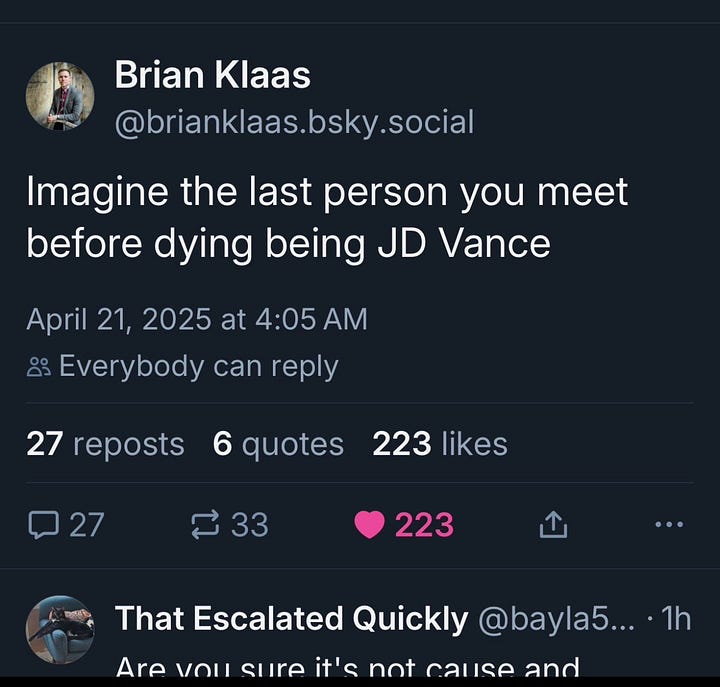
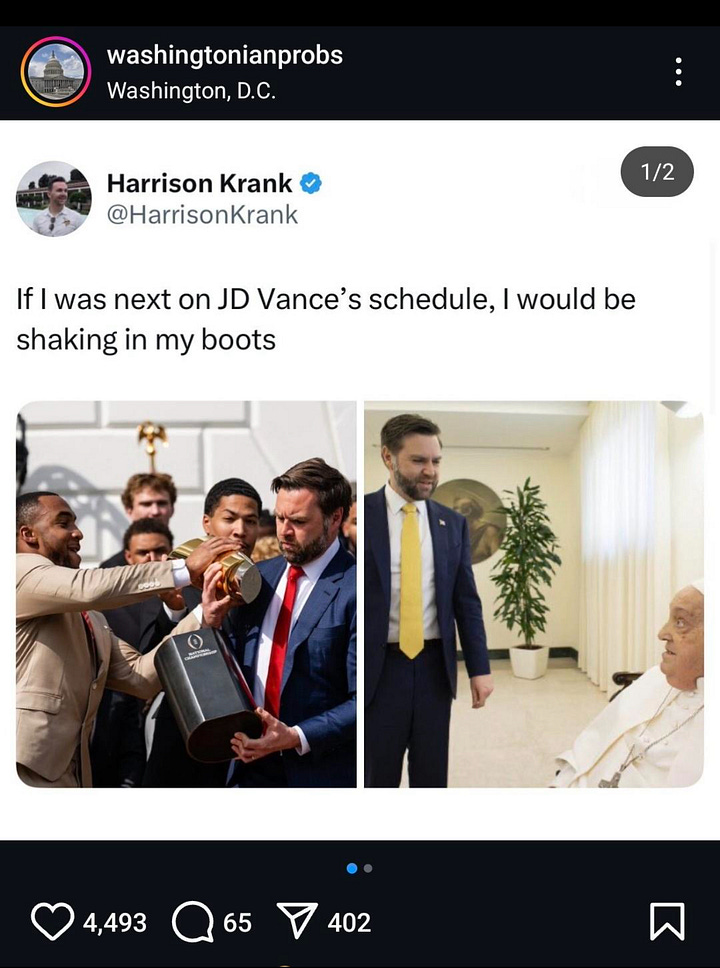
Lastly, given that the popes tend to somehow manage to reflect what’s happening in the United States, I worry about who will succeed Pope Francis. Here are the men who are thought to be contenders.
Let’s all pray, whether or not you’re a praying person, that the Vatican chooses someone with even half the humanity of Pastor Bergogli.


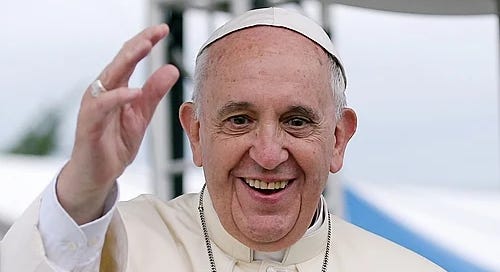



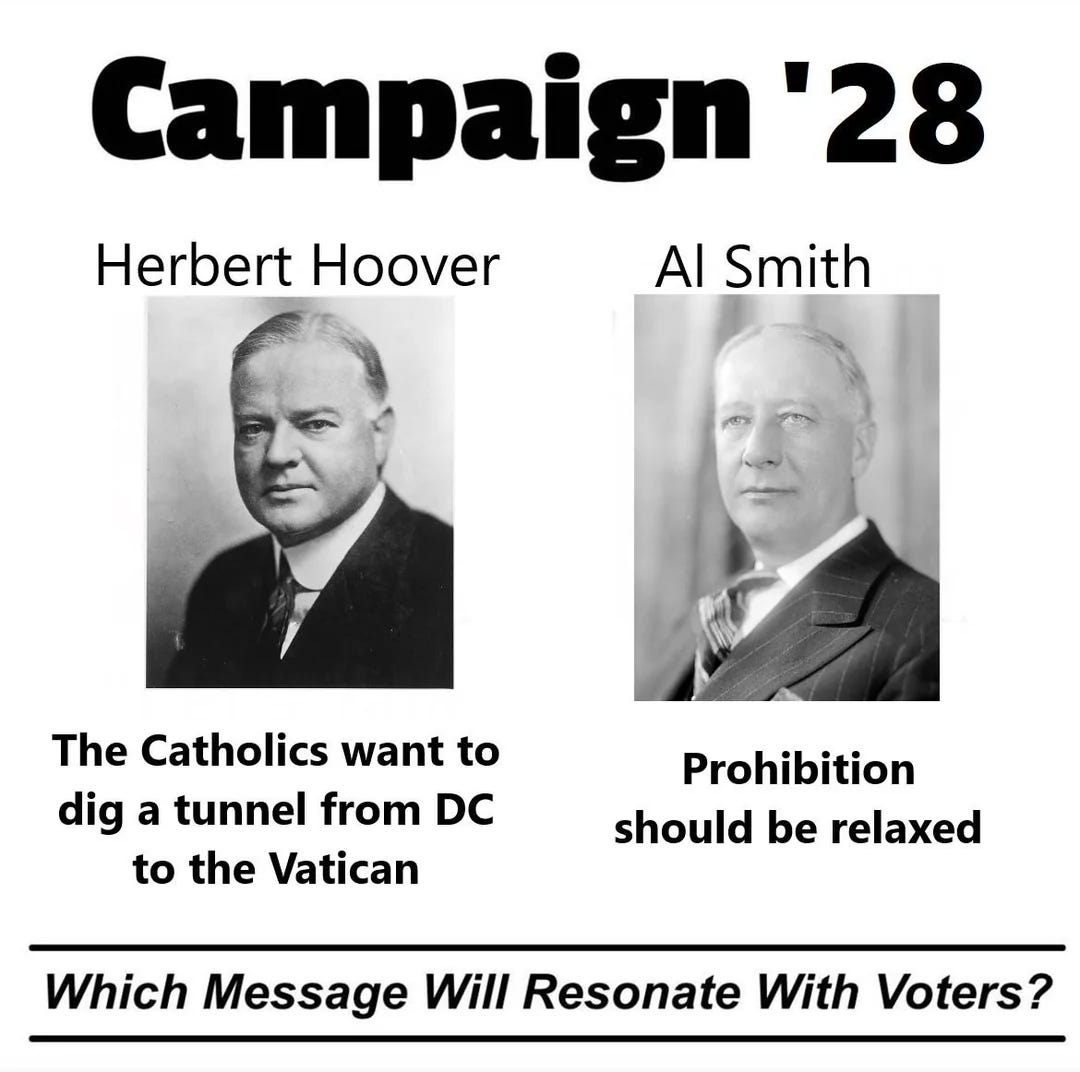
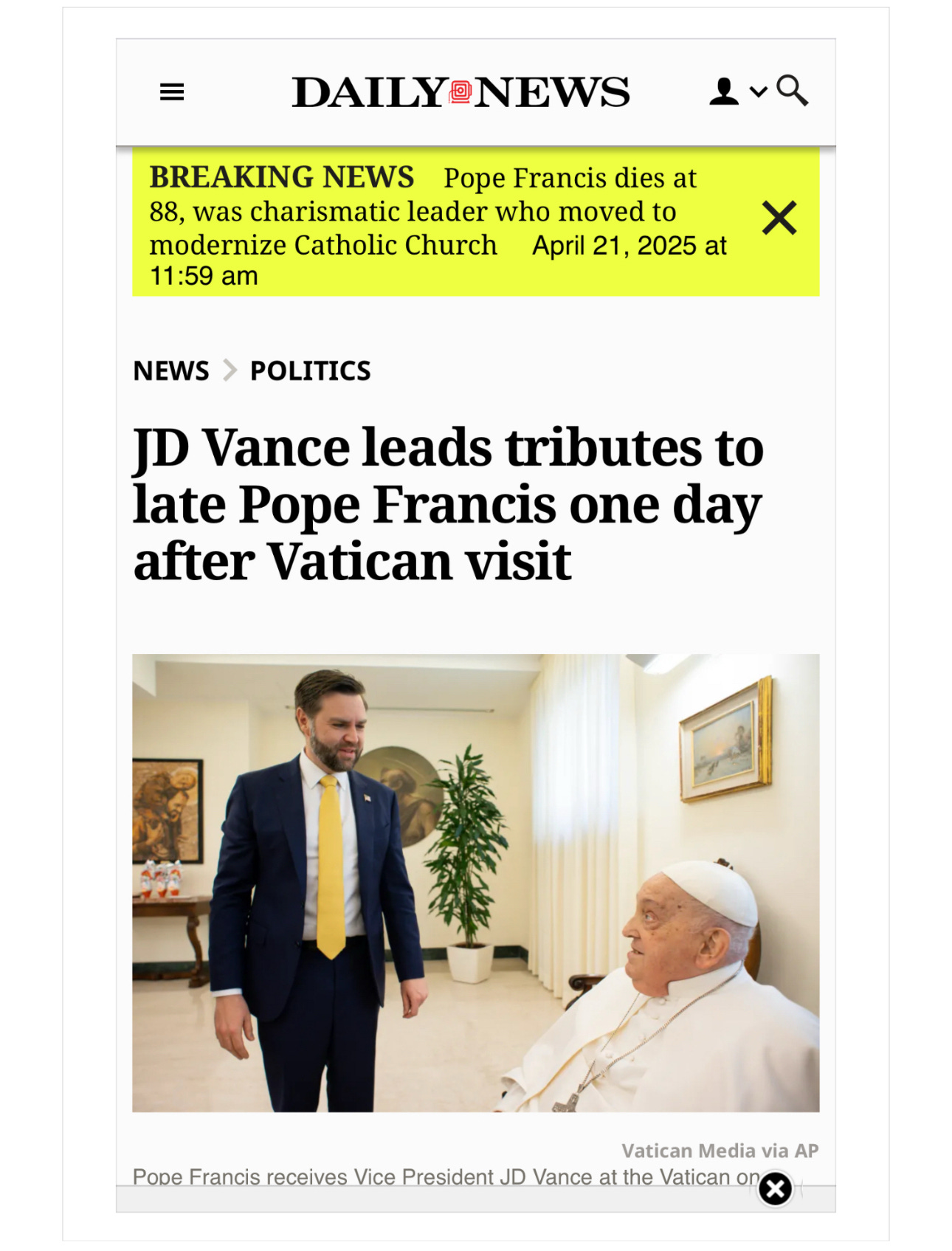
I absolutely love your writing. I miss seeing you on MSNBC but have gained a deeper appreciation for your prose. Not just insightful, but your style and personality infuses every sentence. Glad to be aboard for the adventure!
A beautiful obituary. I always learn many things when I read Joy Reid!
I realized that this pope was a caring person when, during the Covid quarantines, I turned on the TV and saw him doing a televised blessing for anybody who might be watching from home. This was while Donald Trump was saying that Covid was a hoax.